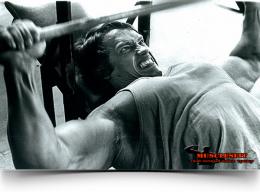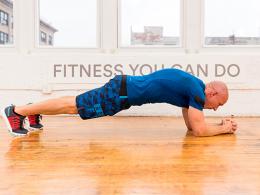How to learn to pull up on the horizontal bar from scratch: a set of exercises for beginners
In this article we will tell you how to learn to pull up on the horizontal bar from scratch. In order for you to master this exercise, even if you still cannot pull yourself up even once, we have selected a set of simple auxiliary exercises that will tell you which muscles you need to pump in order to pull yourself up on the horizontal bar. And how to do it right.
To perform pull-ups, strong arms alone are not enough. To learn how to pull yourself up on the horizontal bar, you need to develop the strength of the auxiliary muscles of the back and the mobility of the joints. If you regularly and actively work out in the gym or do HIIT workouts, but still cannot reach the bar with your chin, you are not alone.
Pull-ups are generally considered an upper-body exercise, but if you want to improve your technique in your shoulders, shoulder blades, and thoracic spine, you need stability and tension in every other part of your body to do it.
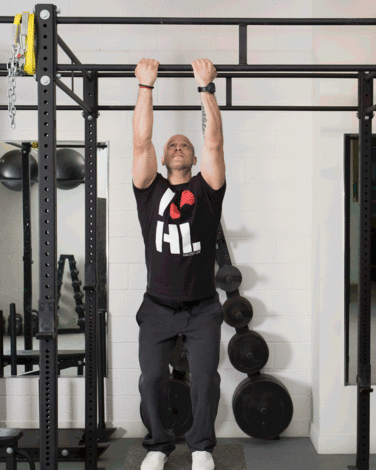 In short, pull-ups are a difficult exercise. You hang on the horizontal bar, and then pull your body weight up. Pull-ups are perhaps the best indicator of strength. That is, they demonstrate how strong you are in relation to your own weight. If you've ever done other bodyweight exercises (like push-ups or planks) or done any yoga pose on your forearms, you know how difficult it can be.
In short, pull-ups are a difficult exercise. You hang on the horizontal bar, and then pull your body weight up. Pull-ups are perhaps the best indicator of strength. That is, they demonstrate how strong you are in relation to your own weight. If you've ever done other bodyweight exercises (like push-ups or planks) or done any yoga pose on your forearms, you know how difficult it can be.
Another important point to keep in mind is shoulder mobility. Good mobility of the chest and shoulders allows you to use the latissimus dorsi, the main working muscles in this exercise. If the shoulder girdle does not have the necessary level of mobility, stability and coordination, then the correct performance of pull-ups becomes almost impossible.
A little about how to properly pull up on the horizontal bar from the video.
So how do you learn to do pull-ups? This is not easy to do, but there are several exercises that can help you strengthen the muscles that are involved in pull-ups.
The main working muscles here are the large muscles of the back (the latissimus dorsi and rhomboid), rear deltas and biceps. You will also need to engage your core muscles and maintain the correct position of the shoulders, that is, bringing the shoulder blades together, and not spreading them apart.
What grip to pull up
Exercises to learn how to pull up
How to learn to pull up on the horizontal bar from scratch at home? Very easy, just follow our recommendation and you will be able to pull up in less than a month.
Use this guide as follows:
- If you have already started training and have tried pull-ups, then choose the exercises from the chapter that matches your level of training.
- If you want to learn how to perform pull-ups and are already able to do the exercises from the Advanced Level chapter, then skip to the section "5 phases for gradually moving to pull-ups."
Remember that although we have grouped the exercises according to their difficulty, you can still benefit from any of them regardless of your fitness level. When deciding how to learn how to pull up on the horizontal bar, the main task is to develop the strength of the desired muscle groups.
First level
holding dumbbells
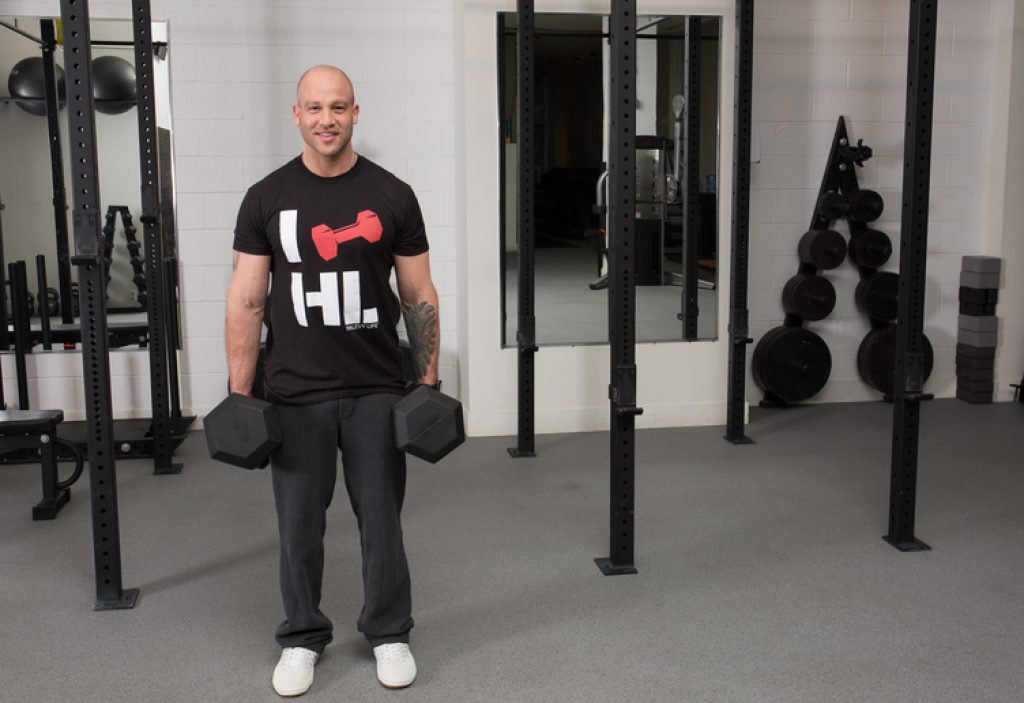
Stand up straight, feet hip-width apart. Take dumbbells in your hands and lower them to the sides along the torso. Keep your back straight. Hold the dumbbells by tensing your biceps, and not just holding them in extended arms. Do the exercise for 30 seconds. If it seems difficult to you, then use a lighter weight. Rest for 60 seconds. Repeat 3 times.
For even better grip strength, hold the dumbbells by the discs for 30 seconds instead of by the handles.
Hanging on the crossbar
Grasp the bar with an overhand grip, lift your legs off the floor and hang on it. Keep your core muscles tight. You can rotate your shoulders, trying to pull them down (rather than pressing them against your neck) to bring your shoulder blades together. Keep your shoulder blades straight and engage your back muscles. Repeat the exercise 5 times.
Reduction of the shoulder blades in the hang
Grasp the bar with an overhand grip and lift your legs off the floor. Drop your shoulders and squeeze your shoulder blades together. Relax and return your shoulder blades to their original position. Repeat 15 times.
Advice from a professional: perform this exercise, imagining that you have someone's finger between your shoulder blades, and you are trying to squeeze it with them. You will pull your shoulders back slightly, but do this movement, including the muscles of the back, and not just the shoulders.
Incline Dumbbell Row
Take dumbbells in each hand. Lie face down on an incline bench. The head should hang over the edge of the bench. Place your feet on either side of the bench, relax and bend your knees slightly. Keeping your elbows close to your body, pull the dumbbells up (as if rowing with oars), bringing your shoulder blades together. Dumbbells should be in line with the chest or waist, and not with the armpits. Hold this position for 10 seconds. Repeat 5 times.
Average level
plank
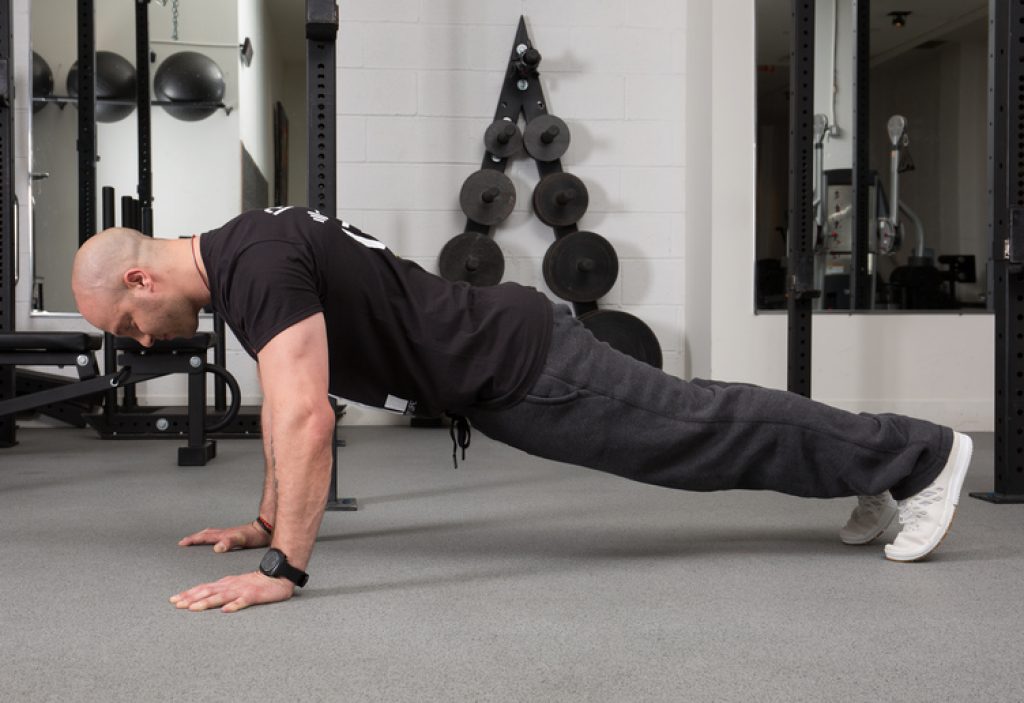
Take an emphasis lying down. The palms should be directly under the shoulders. Straighten your legs and spread them hip-width apart. Tighten your core muscles and keep your body straight from head to toe. Don't let your hips sag or rise up! Hold the position for 60 seconds. Take a rest. Do 3 times.
"Boat" on the back
Lie on the floor face up, straighten your legs, stretch your arms behind your head. Tighten your abdominal muscles and, without lifting your lower back from the floor, raise your arms, head and legs up. Hold the position for 15 seconds. Repeat 5 times.
Block pull lying on a bench
Lie on an incline bench, face up, with your back to the block machine. Place your feet on the floor and relax. Raise your arms above your head and grasp the handle of the machine. Keeping your arms straight, squeeze your shoulder blades together and pull the bar down towards your chest. Slowly return your hands to the starting position. Do 15 reps.
Holding cargo disks
Stack 2 or more small cargo discs together. Standing in a relaxed position with your arms at your sides, clasp them in your palms and hold for at least 30 seconds.
If the exercise seems difficult for you, reduce the working weight. Rest for 60 seconds. Repeat 3 times.
Advanced level
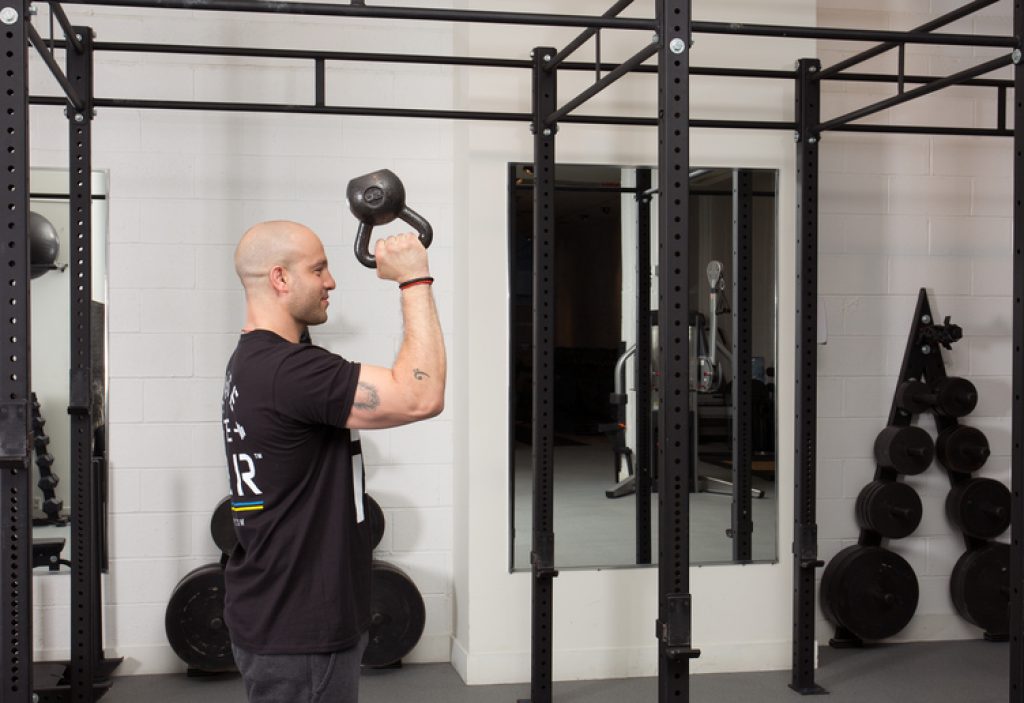
kettlebell press
Take the kettlebell in your right hand. Bend your arm at the elbow and lift the weight with the lower part up to chest level. Slowly push the kettlebell up over your head. Do 15 reps and then change hands.
Horizontal pull-ups
Place an empty bar on a power rack at chest level. Grasp the bar with an overhand grip, spread your arms shoulder-width apart and bend at the elbows. Step forward under the bar so that your body is at an angle to the floor and your face is facing up. Keeping your legs straight and pressing your elbows to your body, straighten your arms and lower your body down. Then, bringing the shoulder blades together, pull yourself up, moving your chest towards the bar.
Rollouts with a fitball
Get on your knees, join your palms and lower your hands to the fitball. Keeping your body straight from head to toe (do not lower or raise your hips) and, resting your forearms on the fitball, slowly roll it forward. Tighten your abdominal muscles to return to the starting position. Do 15 reps.
Lifting the bar for biceps
Grab an empty bar with an underhand grip. Keeping your elbows close to your body, do 100 biceps curls as quickly as possible while maintaining the technique of the exercise.
5 phases for a gradual transition to pull-ups
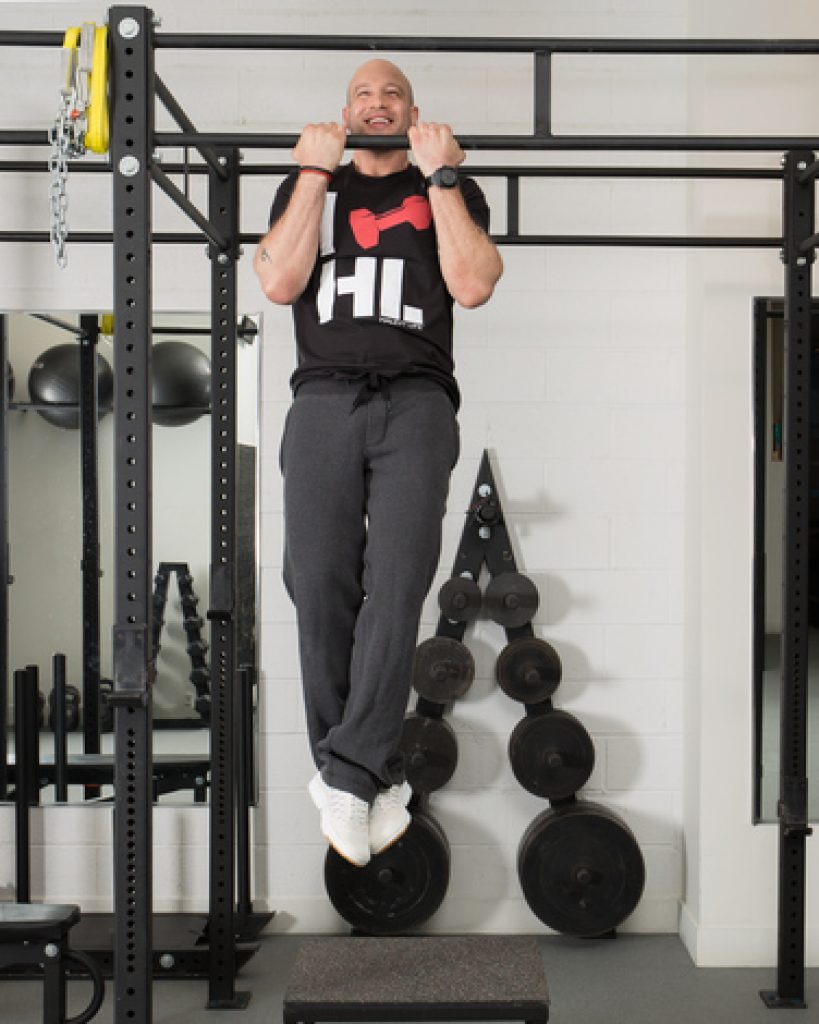 Phase #1: Isometric Hold
Phase #1: Isometric Hold
Goal: Hold your chin over the bar for 60 seconds
Grab the bar with an underhand grip. Stand on a bench with your chin at or above the bar. Squeeze your shoulder blades together, tighten your core muscles, and then lift your legs off the bench, keeping your chin over the bar for as long as you can. Rest between sets for 2 minutes. Repeat, trying to hold on longer than in the previous set.
When you can keep your chin over the bar for 60 seconds, move on to the second phase.
 Phase #2: Negative Pullups
Phase #2: Negative Pullups
Goal: Complete 3 sets of 15 seconds
Using a bench, stand with your chin at or above the bar. With bent arms, grasp the bar with an underhand grip. Lift your legs off the bench and lower your body down, extending your arms as slowly as possible. Try to go down for 15 seconds. After completing the repetition, rest for 1 minute. Do 3 reps in 3 sets. Rest 2 minutes between sets.
When you can do 3 sets, move on to phase #3.
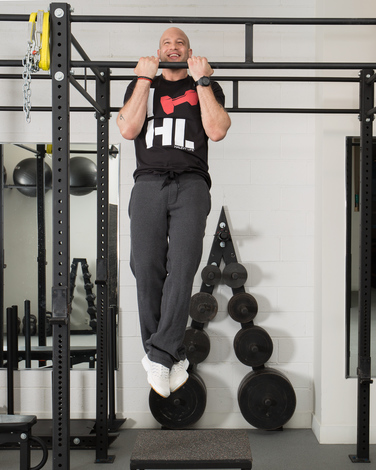 Phase number 3: pull-ups with an expander
Phase number 3: pull-ups with an expander
Goal: Complete 3 sets of 8 reps with minimal band support
Supported by two legs
Envy the expander for the crossbar. Grab the bar with an underhand grip and place your crossed legs or knees on the band. Perform 8 pull-ups (or as many as you can) while slowly lowering for 15 seconds. This is one approach. Do 3 sets, resting 2 minutes in between.
Supported by one leg
Once you can complete the prescribed number of sets and reps, do the same exercise, but with support on the expander with one leg (or knee). You can keep your free leg straight or bend at the knee. Perform 8 pull-ups (or as many as you can) while slowly lowering for 15 seconds. This is one approach. Do 3 sets, resting 2 minutes in between.
Phase 4: pull-ups with a partner
Purpose: to perform pull-ups without the help of an expander
Grab the bar with an underhand grip. Do as many pull-ups as you can. The partner should push you in the hips at the moment when you pull yourself up to the bar, but you should always lower yourself without his help. As soon as you feel tired, rest for 2 minutes, and do 3 more of the same set.
Phase 5: pull-ups
Purpose: to perform pull-ups without assistance
Grasp the bar with an underhand grip and do as many pull-ups as you can. Gradually, as you progress, move from the grip from below to the grip from above.


